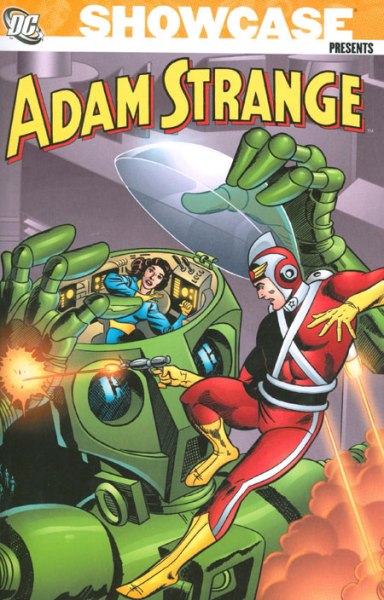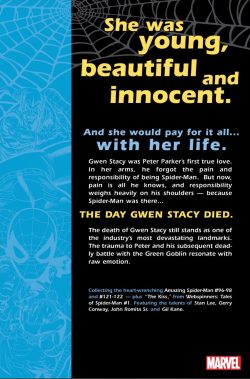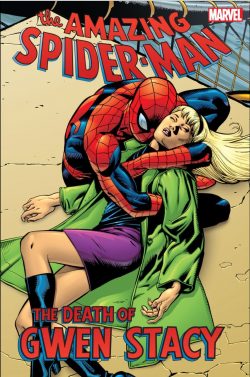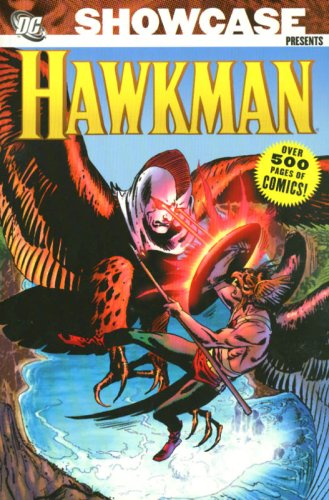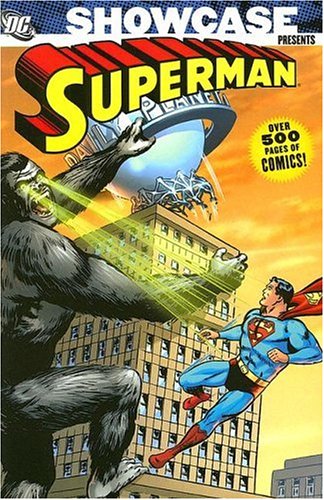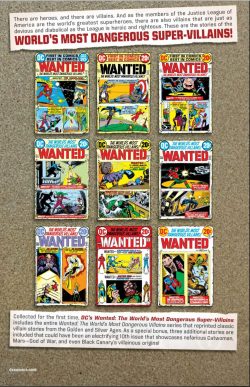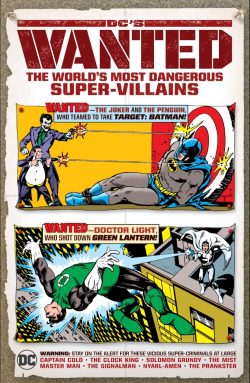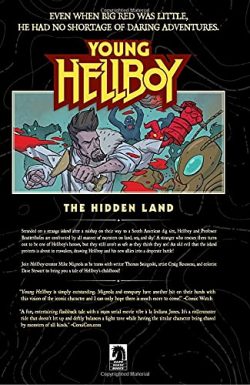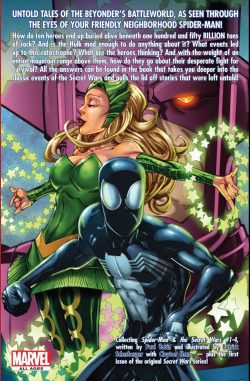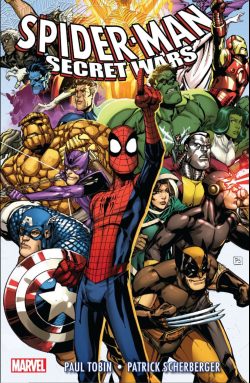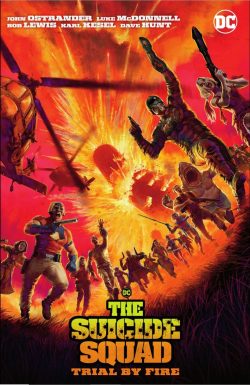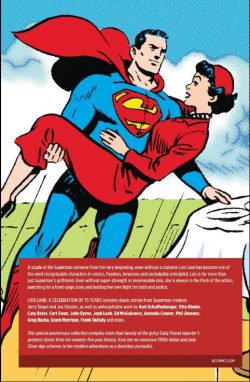
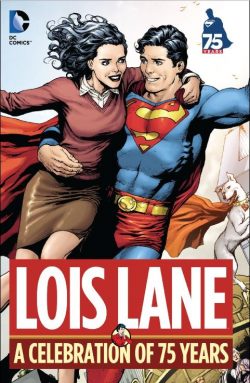
By Jerry Seigel & Joe Shuster, Don Cameron, William Woolfolk, Whitney Ellsworth, Jerry Coleman, Robert Kanigher, Cary Bates, John Byrne, Jeph Loeb, Phil Jimenez, Katheryn Immonen, Greg Rucka, Grant Morrison, Ed Dobrotka, Sam Citron, Al Plastino, Wayne Boring, Curt Swan, Kurt Schaffenberger, Ed McGuiness, Matthew Clark, Renato Guedes, Frank Quitely & various (DC Comics)
ISBN: 978-1-4012-4703-4 (HB/digital)
The greatest romance in comics is undoubtedly the first one. Whether as humble Clark Kent or the magnificent Man of Steel, the eternal relationship between a feisty female reporter and Superman is the first and longest-lasting couple dynamic in comic books
When the Man of Steel debuted in Action Comics #1 (June 1938) he was instantly the centre of attention, but even then, the need for a solid supporting cast was understood and cleverly catered for. Glamorous daredevil journalist Lois Lane premiered right beside Kent – rival, companion and foil from the outset.
This stunning compilation – part of a dedicated series introducing and exploiting the comics pedigree of venerable DC icons – is still available in hardback and digital formats, even if DC have decided not to give her an 80-year update like so many of her near contemporaries, offering a sequence of snapshots detailing how the original “plucky news-hen†has evolved right beside the Man of Tomorow in that “never-ending battleâ€â€¦
The groundbreaking appearances selected are preceded here by a brief critical analysis of the significant stages in Lois’ development, beginning with Part I 1938-1956: Girl Reporter…
Most early tales were untitled, but for everyone’s convenience have been given descriptive appellations by the editors. Thus, after describing the foundling’s escape from exploding Planet Krypton and explaining his astonishing powers in nine panels, with absolutely no preamble, the wonderment begins in ‘Superman, Champion of the Oppressed’ and ‘War in San Monte’ from Action Comics #1 & 2 (June and July 1938 by Jerry Seigel & Joe Shuster) as the costumed crusader – masquerading by day as a reporter – began averting numerous tragedies.
As well as saving an innocent woman from the electric chair and roughing up a wife-beater, the tireless crusader worked over racketeer Butch Matson – consequently saving his suave and fearless colleague from abduction and worse since she was attempting to vamp the thug at the time!
The mysterious Man of Steel made a big impression on her by then outing a lobbyist for the armaments industry who was bribing Senators on behalf of greedy munitions interests fomenting war in Europe…
The next breathtaking instalment sees the mercurial mystery-man travelling to the actual war-zone and spectacularly dampen down the hostilities already in progress, after which (in #6) canny chiseller Nick Williams attempts to monetise the hero – without asking first. ‘The Man Who Sold Superman’ (Action Comics #6 1938, by Seigel & Shuster) had Superman’s phony Manager even attempting to replace the real thing with a cheap, musclebound knock-off before learning a very painful lesson in business ethics…
In those turbulent times, the interpretation of our dogged data-fiend was far less derogatory than the post-war sneaky minx of the 1950s and 1960s. Lois might have been ambitious and life-threateningly precipitate, but it was always to advance her own career, help underdogs and put bad guys away, not trap a man into marriage. At his time, she was much more Nellie Bly than Zsa Zsa Gabor.
After proving a worthy rival and foil to Kent and his alter ego, Lois won her own solo feature beginning in Superman #28 (May/June 1944). Examples included here begin with ‘Lois Lane, Girl Reporter: The Bakery Counterfeiters’(Superman #29, July/August 1944, by Don Cameron, Ed Dobrotka & George Roussos), which finds her turning her demotion to the women’s cookery pages into another blockbusting scoop after uncovering a crafty money scam at a local patisserie…
In Superman #33 (March 1945), Whitney Ellsworth & Ed Dobrotka detailed how a typically cruel prank by male colleagues and cops turns into another front-page scoop as ‘Lois Lane, Girl Reporter: The Purloined Piggy Bank’ has her help a little kid and unmask big time jewel thieves before ‘Lois Lane, Girl Reporter: The Foiled Frame Up’ (Superman#34 May 1945 by Ellsworth, Sam Citron & Roussos) sees her ferret out political corruption by exposing grafters seeking to discredit Daily Planet Editor Perry White…
Originally seen in Superman #58 (May-June 1949), ‘Lois Lane Loves Clark Kent’ is by William Woolfolk, Wayne Boring & Stan Kaye: a beguiling teaser finding our “Girl Friday†(that’s a movie reference: look it up) consulting a psychiatrist because of her romantic obsession with the Man of Steel. The quack tells her to switch her affections to her bewildered, harassed workmate!
Part II 1957-1985: Superman’s Girl Friend takes us into the world of consumerist domesticity and when Lois Lane – the oldest supporting character/star in the Superman mythology if not the DC universe – finally received her own shot at a solo title, it was very much on the terms of the times.
When the Adventures of Superman television show launched in the autumn of 1952, it was an overnight sensation and National Periodicals began cautiously expanding their revitalised franchise with new characters and titles. First to win promotion to solo-star status was the Daily Planet’s impetuously capable if naïve “cub reporterâ€. His gloriously charming, light-hearted, escapades began in Superman’s Pal Jimmy Olsen #1 (September-October 1954): the first tie-in titan in the Caped Kryptonian’s ever-expanding entourage.
It took three years for cautious Editors to tentatively push the boat out again. In 1957, just as the Silver Age of Comics was getting going, try-out title Showcase followed up the launches of The Flash in #4 and Challengers of the Unknownin #6, delivered a brace of issues entitled Superman’s Girl Friend Lois Lane.
Soon after, the she had a series of her own. Technically it was her second, following her brief mid-1940s solo back-ups in Superman, but this time that caped guy was always hanging around…
In previous reviews I’ve banged on at length about the strange, patronising, parochial – and to some of us, potentially offensive – portrayals of kids and most especially women during this period, and although at least fairer and more affirmative instances were beginning to appear, the warnings still bear repeating. Don’t even dream of any characters of colour at this time, unless they look like contemporary cinematic sultans and sheiks…
At that time, Lois Lane was one of precious few titles with a female lead, and, in the context of today, one that gives many 21st century fans a few uncontrollable qualms of conscience. Within the confines of her series, the valiant, capable working woman careened crazily from man-hungry, unscrupulous bitch, through ditzy simpleton to indomitable and brilliant heroine – often all in the same issue.
The comic was clearly intended to appeal to the family demographic that made I Love Lucy a national phenomenon and Doris Day a saccharine saint, with many stories played for laughs in that same “father knows best†or  “gosh, aren’t women funny?†tone that appals me today – but not as much as the fact that I still love them to bits.
It honestly helps that they’re mostly sublimely illustrated by the wonderfully whimsical Kurt Schaffenberger.
During the 1950s and early 1960s in America, being different was a bad thing. Conformity was sacrosanct, even in comic books, and everybody and thing was meant to keep to its assigned and intended role. For the Superman family and cast, the tone of the times dictated a highly-strictured code of conduct and ironclad parameters: Daily Planet Editor Perry White was a stern, shouty elder statesman with a heart of gold, Cub Reporter Jimmy Olsen was a bravely impulsive unseasoned fool – with a heart of gold – and Plucky News-Hen (what does that even mean?) Lois was brash, nosy, impetuous, unscrupulous and relentless in her obsession to marry Superman, although she too was – deep down – also in possession of an Auric aorta.
Yet somehow, even with these mandates in place the talented writers and artists assigned to detail their wholesomely uncanny exploits managed to craft tales both beguiling and breathtakingly memorable: frequently as funny as they were exciting.
I must shamefacedly admit to a deep, nostalgic affection for her bright, breezy, fantastically fun adventures, but as a free-thinking, (notionally) adult liberal of the 21st century I’m simultaneously shocked nowadays at the jolly, condescending misogynistic attitudes underpinning too many of the stories.
Yes, I’m fully aware that the series was intended for young readers at a time when “dizzy dames†and matronly icons played to the popular American gestalt stereotype of Woman as jealous minx, silly goose, diffident wife and brood-hungry nester, but to ask kids to seriously accept that intelligent, courageous, ambitious, ethical and highly capable females would drop everything they’d worked hard for to lie, cheat, inveigle, manipulate and entrap a man just so that they could cook pot-roast and change super-diapers is just plain crazy and tantamount to child abuse.
I’m just saying…
Showcase #9 (cover-dated July/August 1957) featured Superman’s Girl Friend Lois Lane and opened with the seminal yarn ‘The Girl in Superman’s Past’ (by Jerry Coleman & Al Plastino) wherein Lois first meets red-headed hussy Lana Lang: childhood sweetheart of Superboy and a pushy conniving go-getter out to win Lois’ intended at any and all costs. Naturally Miss Lane invited Miss Lang to stay at her apartment and the grand rivalry was off and running…
Then ‘The New Lois Lane’ (Otto Binder, Ruben Moreira & Plastino) aggravatingly sees Lois turn over a new leaf and stop attempting to uncover his secret identity just when Superman actually needs her to do so…
Superman’s Girlfriend Lois Lane #1 (March/April #1958) then confirms all stereotypes in Binder & Schaffenberger’s ‘The Fattest Girl in Metropolis’: wherein a plant growth ray accidentally super-sizes our vain yet valiant reporter. Imagine her reaction when she finds out that Superman had deliberately expanded her dimensions… for good and solid reasons, of course…
In ‘The Kryptonite Girl’ (Superman’s Girlfriend, Lois Lane #16, April 1960), Siegel & Schaffenberger were responsible for another cruel lesson as Superman tries to cure Lois’ nosy impulses by tricking his own girlfriend into believing she has a radioactive death-stare. Of course, as all married couples know, this power develops naturally not long after the honeymoon… I love these stories, but sometime words just fail me…
As contrived by Leo Dorfman & Schaffenberger, a personality-altering head blow then causes Lois to try tricking her Man of Steel into matrimony in ‘The Romance of Superbaby and Baby Lois’ (#42, July 1963). Sadly, whilst conniving, she employs a stolen rejuvenation chemical which cause them to de-age below the age of legal consent…
Happily, the late 1960s, Feminism and the general raising of female consciousness rescued Lois from demented domesticity, and by the time of Superman’s Girlfriend, Lois Lane #106 (November 1970) she was a competent, combative, totally capable go-getting journalist every inch the better of her male rivals. It’s a shame more of those stories aren’t included in this collection.
However, ‘I Am Curious (Black)!’ by Robert Kanigher, Werner Roth & Vince Colletta showed the lengths she would go to get her story. Unable to truly grasp the nature of being African American, she borrows Kryptonian tech to become black for 24 hours, and realises how friends, acquaintances and even fellow liberals respond to different skins. She even asks Superman if he would marry her in her altered state…
Big changes and modifications were set in place for Part III 1986-1999: Lois and Clark.
When DC Comics decided to rationalise and reconstruct their continuity with Crisis on Infinite Earths, they used the event to regenerate their key properties. The biggest shake-up was Superman, and it’s hard to argue that the change was unnecessary. The old soldier was in a bit of a slump, but he’d weathered those before. So how could a root and branch overhaul be anything but a marketing ploy that would alienate real fans for a few fly-by-night chancers who would jump ship as soon as the next fad surfaced?
Superman’s titles were cancelled/suspended for three months, and boy, did that make the media sit-up and take notice – for the first time since the debut Christopher Reeve movie. But there was method in this corporate madness…
Man of Steel – written and drawn by John Byrne and inked by Dick Giordano – stripped away vast amounts of accumulated baggage and returned the hero to the far from omnipotent, edgy but good-hearted reformer Siegel & Shuster had originally envisioned. It was a huge and instant success, becoming the industry’s premiere ‘break-out’ hit, and from that overwhelming start Superman re-inhabited his suspended comic book homes with the addition of a third monthly title premiering the same month.
The miniseries presented six complete stories from key points in Superman’s career, reconstructed in the wake of the aforementioned Crisis. Man of Steel #1 revealed a startling new Krypton in its final moments before following the Last Son in his escape, through his Smallville years to his first recorded exploit and initial encounter with Lois.
Byrne was a controversial choice at the time, but he magnificently rekindled the exciting, visually compelling, contemporary and even socially aware slices of sheer exuberant, four-colour fantasy that was the original Superman, making it possible and fashionable to be a fan again, no matter your age or prejudice. Superman had always been great, but Byrne had once again made him thrilling and unmissable.
Included here is ‘The Story of the Century’ from Man of Steel #2 (October 1986) wherein fiery lead reporter Lois Lane puts all her efforts into getting the landmark exclusive first interview with Metropolis’ mystery superhero, only to be ultimately scooped by a nerdy, hick new hire named Kent…
We then skip to anniversary issue Action Comics #600 (May 1988) for an untitled segment courtesy of Byrne, Roger Stern, Schaffenberger, Jerry Ordway of a mammoth ensemble piece. Codified for easy access as “Lois Laneâ€, the tale depicts the jaded journalist – fresh from beating up and arresting a gang of thugs – rendezvous with rival Kent to discuss Superman’s possible romance with Wonder Woman…
As years passed, Lois and Clark grew beyond professionalism into a work romance, but the hero kept his other identity from her. That all changed after the Man of Tomorrow narrowly defeated mystic predator Silver Banshee and decided there would no more ‘Secrets in the Night’ between him and his beloved (Action Comics #662, February 1991, by Stern & Bob McLeod).
Having finally married her man (in 1996) Lois and Clark settled down into a life of hectic wedded bliss, but trouble was never far from the happy couple.
Created as part of the Girlfrenzy publishing event, ‘Lois Lane’ from one-shot Superman: Lois Lane #1 (June 1998 by Barbara Kesel, Amanda Conner & Jimmy Palmiotti) sees the relentless reporter heading to Canada to singlehandedly bust a child-snatch ring and illicit genetics-mutation lab…
In Part IV 2000-Present: Twenty-First Century Lois, the era of domesticity was marred by many external problems, such as Lex Luthor finagling himself into America’s presidency. ‘With This Ring’ (Superman #168, May 2001 from Jeph Loeb, Ed McGuiness & Cam Smith) details how Lois and Batman infiltrate the White House to steal the gimmick Bad PotUS has been using to keep the Man of Steel at bay, after which ‘She’s a Wonder’ (Wonder Woman #170 (July 2001, by Phil Jimenez, Joe Kelly & Andy Lanning) offers a pretty but relatively slow day-in-the-life tale.
Here Lois interviews the impossibly perfect Amazon cultural ambassador to Mans’s World – and potential romantic rival – providing readers with valuable insights into both.
Greg Rucka, Mathew Clark, & Renato Guedes & Nelson then craft ‘Battery: Part Five’ (Adventures of Superman #631, October 2004) as Lois’s devil-may-care luck finally runs out and the Caped Kryptonian arrives seconds too late after she becomes a sniper’s target.
Slipping back into comedy, ‘Patience-Centred Care’ comes from Superman 80-Page Giant 2010, where Katheryn Immonen & Tonci Zonjic show how even the Action Ace can’t cope with a bed-ridden wife who won’t let flu stop her nailing a story…
Part V 1957-1985: Imaginary Tales then takes a step sideways to highlight the many memorable out-of-continuity stories the Superman-Lois relationship has generated. ‘The Wife of Superman’ was part of an occasional series running in early issues of Superman’s Girlfriend, Lois Lane. Probably scripted by Seigel and definitely drawn by Schaffenberger, this third outing (from #23, February 1961), revisits a possible future wherein Lois is worn to a frazzle by two unmanageable super-toddlers and yearns for her old job at the Daily Planet…
From a period where Golden Age stories were assumed to have occurred on parallel world Earth-Two, ‘Superman Takes a Wife’ comes from 40th Anniversary issue Action Comics #484 (June 1978). Here Cary Bates, Curt Swan & Joe Giella detail how the original Man of Tomorrow became editor of the Metropolis Daily Star in the 1950s and married Lois. Thanks to villainous rogues Colonel Future and the Wizard who had discovered a way to make Superman forget his own existence, only she knew that her husband was once Earth’s greatest hero…
When I was a nipper, Superman had outlandish adventures and was a decent regular guy. His head could be replaced by a lion’s or an ant’s and he loved playing jokes on his friends. His exploits were routinely mind-boggling and he kept a quiet dignity about him. He only shouted to shatter concrete, and not to bully villains. He was quietly cool.
And in All Star Superman he was again. Grant Morrison & Frank Quitely produced a delightful evocation of those simpler, gentler times with a guided tour of the past redolent with classic mile-markers. Superman was the world’s boy scout, Lois was spending her days trying to prove Clark is the Man of Steel, Jimmy Olsen was a competent young reporter dating Lucy Lane and all of time and space knew they could always rely on the Man of Tomorrow.
As seen in All-Star Superman #2 and 3 (February and May 2006), ‘Superman’s Forbidden Room’ and ‘Sweet Dreams, Superwoman’ sees Lois takes centre stage as a plot to kill Superman forces the hero to acknowledge his feelings for her. The result is an astonishing trip to his Fortress of Solitude and a hyper-empowering birthday gift she will never forget… Wrapping up the recollections is an astounding Cover Gallery to accompany the works already seen in conjunction with the stories cited above, with covers by Shuster, Swan & Stan Kaye, Schaffenberger, Murphy Anderson, Byrne, Kerry Gammill & Brett Breeding, Leonard Kirk & Karl Story, Ed McGuiness & Cam Smith, Adam Hughes, Gene Ha, José Luis GarcÃa-López, Quitely & Jamie Grant.
These extras comprise Superman #51 (March/April 1948) and Action Comics #137 (October 1949), both by Boring & Kaye; Superman’s Girlfriend, Lois Lane #1 (April 1958) by Swan & Kaye; issue #25 (May 1961) by Schaffenberger; #80 (January 1967) by Swan & Neal Adams and #111 (July 1971) by Giordano.
Later classics covers include Superman volume 2 #59 (September 1991) by Dan Jurgens & Brett Breeding; Superman: The Wedding Album and Beyond (1995) by Jurgens & Ordway; Superman volume 2 #157 (June 2000) by McGuiness & Smith; Superman Returns Prequel #4 (August 2006) by Hughes; Superman Confidential #2 (February 2007) by Tim Sale and Superman Unchained #1 (2013 variant cover) by José Luis GarcÃa-López.
This monolithic testament to the most enduring love affair in comics is a guaranteed delight for fans of all ages and a perfect introductory time capsule for all readers of fantastic fiction.
© 1940, 1942, 1952, 1954, 1957, 1960, 1961, 1963, 1972, 1983, 1986, 1987, 1992, 1997, 2001, 2005, 2006, 2007, 2010, 2014, 2015 DC Comics. All Rights Reserved.

